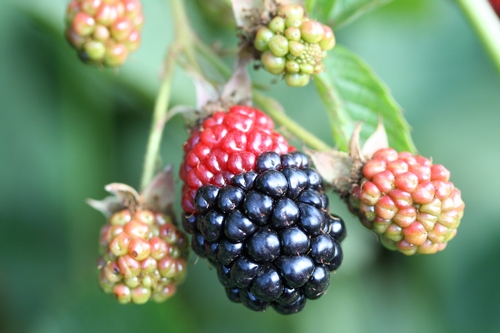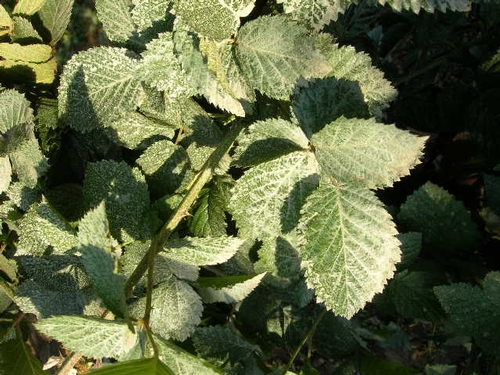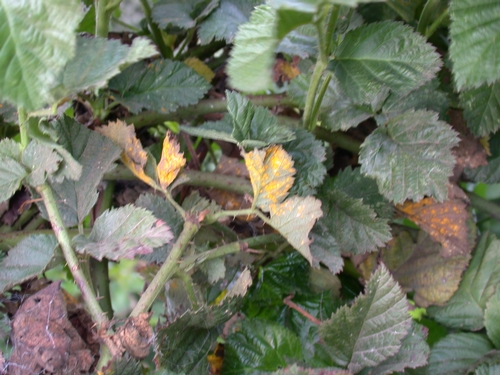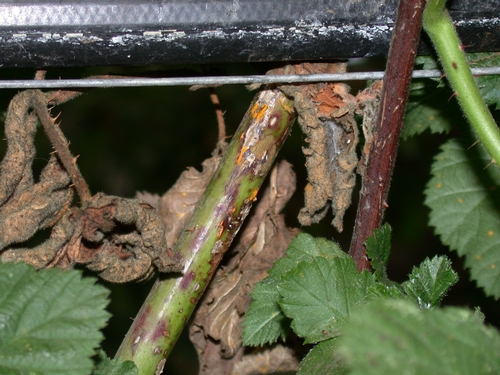
Posts Tagged: lime
Utility of Fall Applied Lime Sulfur in Reducing Incidence of Redberry Mite in Blackberry
As readers of this space already know, the utility of fall applied lime sulfur for controlling redberry mites in blackberries has been questioned. Previous collaborative work has shown that 3-4 applications of Golden Pest Spray oil at a dilution of 1.2 – 2% volume to volume applied at the 50% green fruit stage in the spring is the most effective way to control this pest in blackberry.
This past year, the authors partnered to test the thesis that fall applied lime sulfur, with and without flowable sulfur, would not have an effect on total redberry mite infestation later on in the season. The trial consisted of each treatment (no winter application, 15 gal/A lime sulfur applied twice, and 15 gal/A lime sulfur + 10 lb/A flowable sulfur applied twice) being replicated four times. In turn, each treatment replicate plot was composed of three side by side 250 foot long tunnels, with each tunnel covering three rows of blackberries (meaning each treatment replicate had nine rows of blackberries).
First application of 15 gal of lime sulfur and 15 gal of lime sulfur + 10 lbs wettable sulfur was made November 18, 2013 and the second application of the same was made January 17, 2014. In the spring, two applications each were made of of wettable sulfur (12 lbs per acre) and Golden Pest Spray oil (1.5% to 2%). All other crop and pest management procedures were made as necessary to the maintenance of the crop.
Starting June 29 and continuing weekly through the end of July for a total of six evaluations, total number of marketable fruit and redberry mite fruit were counted in a four foot long section of each three tunnel replicate plot. Statistical evaluation was done as a percentage redberry mite infested fruit compared to total amount of fruit.
As the reader can see from the data presentation below, lime sulfur used either alone or lime sulfur applied with sulfur had no effect on redberry mite incidence in the field in this study. While it is to be noted that this is a single trial run in a drought year, it nevertheless adds a good data set to the consideration of the question of the utility of fall sulfur applications for redberry mite.
|
Evaluation date |
%RBM affected fruit 6-29-2014 |
%RBM affected fruit 7-3-2014 |
%RBM affected fruit 7-10-2014 |
%RBM affected fruit 7-17-2014 |
%RBM affected fruit 7-24-2014 |
%RBM affected fruit 7-31-2014 |
|
No Winter Treatment |
2.66 |
2.66 |
3.32 |
5.01 |
12.50 |
11.99 |
|
15 gal/acre lime sulfur |
1.70 |
2.81 |
3.25 |
7.23 |
9.44 |
16.93 |
|
15 gal/acre lime sulfur + 10 lb/acre flowable sulfur |
1.94 |
3.20 |
3.73 |
7.69 |
11.82 |
13.06 |
None of the means of the percentages of redberry mite infested fruit differ significantly at the 5% level.

Redberry mite affected blackberry fruit. Note clear demarcation between affected, unripe druplets and those which are not.
An Opinion on the Late Autumn Use of Lime Sulfur Sprays in Pajaro Valley Blackberries
In a conversation with a Pest Control Advisor colleague the other day, we discussed the merits of lime sulfur applications in the fall on blackberries grown in the Pajaro Valley. This is something I have spent considerable time thinking about and have come around to believe, that while not completely supported by empirical evidence, fall application of lime sulfur might not be necessary in our blackberries and is to some extent an artifact of past varieties and practices.
Here is why I maintain fall applications of lime sulfur might not be necessary in blackberries:
1- Redberry mite is not controlled by fall lime sulfur. It is rather controlled by post - bloom applications of horticultural oil or sulfur. This is a fact and has been tested.
2- Lime sulfur used to be critical to control cane and stem rust, Keuhneola uredinis, on the trailing Ollalieberry and continues to be very effective when applied for this disease on that variety in the fall. However, none of our current Arkansas varieties (Apache, Navajo, Choctaw and so on), nor are the proprietary suite of varieties known to be susceptible to this rust. I have yet to see it on the primocane bearing PrimeArk either. I did see a touch of orange rust on a proprietary variety last year, but this rust is not controlled by lime sulfur.
3- Do a mental exercise to test the thesis that fall lime sulfur "cleans up" the remaining blackberry cane in the fall. Mites? Not a great material for these, ditto on whitefly and aphids if they are even around. Quite effective of course on powdery mildew (NOT downy mildew), but again this pathogen is better addressed in my mind a little later in the season when the leaves emerge and fungus more active.
I would enjoy very much for someone to prove me wrong and leave replicated strips untreated with lime sulfur and see what happens next year. I believe this would be useful demonstration and quite possibly a beneficial exercise for the industry as a whole.
The use of lime sulfur is discussed extensively in this article. Before using lime sulfur or any of other pesticide, check with your local Agricultural Commissioner's Office and consult product labels for current status of product registration, restrictions, and use information.

Lime sulfur residue on blackberry leaves

Cane and leaf rust on Ollalieberry- note lack of definition to spore clusters.

Cane and leaf rust on Ollalieberry cane.

Orange rust on Chester blackberry. Note dark orange color, clearly defined borders to spore clusters as well as waxy appearance.
